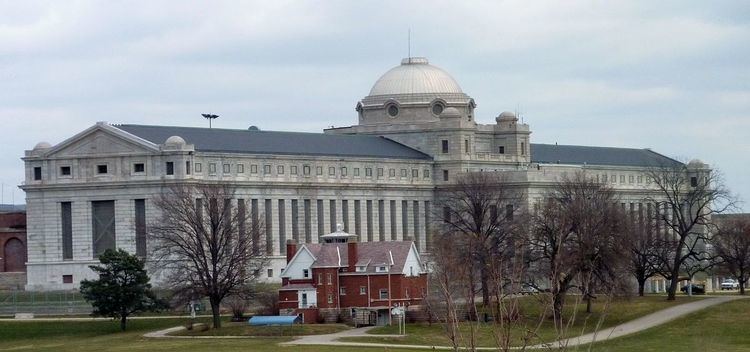Warden Claude Maye Opened 1903 | Status Operational Phone +1 913-682-8700 | |
 | ||
Security class Medium-security (with minimum-security satellite camp) Population 1,870 (475 in prison camp) Address 1300 Metropolitan Ave, Leavenworth, KS 66048, USA Hours Open today · Open 24 hoursSaturdayOpen 24 hoursSundayOpen 24 hoursMondayOpen 24 hoursTuesdayOpen 24 hoursWednesdayOpen 24 hoursThursdayOpen 24 hoursFridayOpen 24 hoursSuggest an edit | ||
United states penitentiary leavenworth
The United States Penitentiary, Leavenworth (USP Leavenworth) is a medium-security United States federal prison for male inmates in northeast Kansas. It is operated by the Federal Bureau of Prisons, a division of the United States Department of Justice. It also includes a satellite federal prison camp (FPC) for minimum-security male offenders.
Contents
- United states penitentiary leavenworth
- Background
- Design
- Historical timeline
- Famous escapees
- Executions
- Cemetery
- References
USP Leavenworth is located 25 miles northwest of Kansas City, Kansas.
Background
The civilian USP Leavenworth is the oldest of three major prisons built on federal land in Leavenworth County, Kansas. It is often confused with, but separate from the United States Disciplinary Barracks (USDB), which is a military facility located on the adjacent Fort Leavenworth. The USDB is 4 miles (6.4 km) north and is the sole maximum-security penal facility of the United States Military. Prisoners from the original USDB were used to build the civilian penitentiary. In addition, the military's medium security Joint Regional Correctional Facility, located southwest of the new USDB, opened in 2010. The USDB and JRCF operate independently from the USP-Leavenworth.
The prison was described by Pete Earley, the only writer at that time who had ever been granted unlimited access to the prison, in his book, The Hot House. The prison's history has also been covered in the pictorial history titled U.S. Penitentiary Leavenworth by Kenneth M. LaMaster, the retired Institution Historian.
USP Leavenworth was the largest maximum-security federal prison in the United States from 1903 until 2005 when it was downgraded to a medium-security facility.
Design
USP Leavenworth was one of three first generation federal prisons which were built in the early 1900s. Prior to its construction, federal prisoners were held at state prisons. In 1895, Congress authorized the construction of the federal prison system.
The other two were Atlanta and McNeil Island (although McNeil dates to the 1870s the major expansion did not occur until the early 1900s).
The prison follows a format popularized at the Auburn Correctional Facility in New York where the cell blocks were in a large rectangular building. The rectangular building was focused on indoor group labor with a staff continually patrolling.
The Auburn system was a marked difference from the earlier Pennsylvania plan popularized at Eastern State Penitentiary in which cell blocks radiated out from a central building (and was the original design for the nearby Disciplinary Barracks before it was torn down and replaced by a totally new prison.
The St. Louis, Missouri architecture firm of Eames and Young designed both Leavenworth and the United States Penitentiary, Atlanta. Leavenworth's prison cells are back to back in the middle of the structure facing the walls. The prison's walls are 40 feet (12 m) high, 40 feet (12 m) below the surface and 3,030 feet (920 m) long and enclose 22.8 acres (92,000 m2). Its domed main building was nicknamed the "Big Top" or "Big House." The domed Disciplinary Barracks two miles (3 km) to the north was nicknamed the "Little Top" until it was torn down in 2004 and replaced with a newer structure.
Historical timeline
Famous escapees
Frank Grigware, imprisoned for train robbery, escaped from Leavenworth in 1910 with five other men by smashing through the prison gates with a hijacked supply locomotive. While the others were quickly recaptured, Grigware escaped to Canada. In 1916 he became the mayor of the Canadian town Spirit River, Alberta. While discovered by the Royal Canadian Mounted Police and the FBI in 1933, serious doubts about his original conviction led the US to drop its extradition request in 1934. Grigware never returned to the US and died in Alberta in 1977.
Basil Banghart escaped from Leavenworth a total of three times. He escaped federal custody a fourth time while awaiting return to Leavenworth.
Executions
On September 5, 1930, serial killer Carl Panzram, under a federal death sentence for murder, was hanged at USP Leavenworth. On August 12, 1938, two men under the sentence of death for murder - Robert Suhay and Glenn Applegate - were hanged at USP Leavenworth.
Cemetery
The penitentiary maintains a cemetery for deceased prisoners, outside the walls of the prison.
